Parking is free for Parents of babies on the neonatal Unit – please ask on the unit for details how to obtain free parking.
Visiting times Neonatal; 24/7 for both parents
Parent’s facilities on unit; we have a parents kitchen with tea and coffee making facilities, fridge and microwave.
We have a parent’s toilet and shower room.
We have 2 parent bedrooms which can be used in preparation for home with baby or if needed for parents of critically unwell babies on the unit.
Parent information leaflets; we have gone paperless with many of our leaflets, the online link is as follows
2 – Cardigan Building
Neptune Children’s’ ward telephone number 01702 386568
We run a range of specialist services for children including; asthma; heart; dermatology; ear, nose and throat surgery; extra crease; foot; general surgery; growth; trauma and orthopaedics; under ones; rheumatology; seizure; special care baby unit; bed-wetting.
All children’s general outpatient and surgical appointments now run from our new state-of-the-art Carlingford Centre, which opened this year.
Jen Foster & Amanda Bourne
For further information please click here
The Neonatal Lead Nurse is
Jen Foster
Maureen Barnes
The Neonatal Lead Clinician is
Vineet Gupta
The Paediatric Critical Care Lead Nurses are
Sophie Dudley
The Paediatric Critical Care Lead Clinician is
Rabia Yousaf
Kilali Ominy-Evbota
The Surgery in Children Lead Nurses are
Kerry Brown
Sophie Dudley
The Surgery in Children Lead Clinician is
Emma Gray
If your baby is born <27 weeks or if you have multiples <28 weeks then as the MSE Trust are all Level 2 Neonatal units (LOCAL Neonatal unit) your baby or babies will need to be stabilised by the unit of the hospital your baby is born in and then transferred out to a Level 3 or Tertiary unit (NICU- Neonatal intensive care unit)
Once your baby has been stabilised at birth either in the delivery suite theatre or delivery room on the delivery unit by the Neonatal unit’s team of doctors and nurses they will be transferred to the unit in a Transport incubator (which keeps baby warm whilst being transferred and can deliver oxygen or breathing support) Once stable on the unit a specialist retrieval team called PANDR (Paediatric and Neonatal decision and retrievals team) will be contacted and dispatch a retrieval team to transfer baby. They arrive with a team of nurses, doctors or advanced nurse practitioners with their own transport incubator and equipment. You may be able to go with your baby but if Mum is still an inpatient then she will not be able to travel with baby unless discharged form Maternity services.
If a prolonged stay is needed maternal care can be transferred to the same hospital as baby if needed.
Southend sits within the East of England region. The East of England region consists of 17 hospitals.
Types of Neonatal Units
Special Care Baby Unit (SCBU, Level 1)
SCBU’s care for babies born from 30 weeks onwards if the baby is a singleton and from 32 weeks if a multiple pregnancy. Babies will receive minimal respiratory support, tube feeding, continuous monitoring and supportive care prior to discharge home.
Local Neonatal Unit (LNU, Level 2)
Local Neonatal units care for babies greater than 27 weeks gestation if a singleton pregnancy and greater than 28 weeks if a multiple pregnancy. Babies cared for in an LNU can receive short term intensive care treatment requiring respiratory support on a ventilator.
Neonatal Intensive Care Unit (NICU, Level 3)
NICU, sometimes referred to as Tertiary/level 3 units. NICU’s care for babies born from 22 weeks gestation, babies who have a surgical need and babies who need prolonged intensive care. Here in the East of England we have 3 NICU’s.
Clusters
Cambridge Cluster
NICU; Addenbrookes
LNU; Broomfield, Colchester, Harlow (Princess Alexandra) and Peterborough
SCBU; Hinchingbrooke and West Suffolk
Norwich Cluster
NICU: Norfolk and Norwich
LNU; Ipswich and Queen Elizabeth (Kings Lynn)
SCBU; James Paget
Luton Cluster
NICU; Luton and Dunstable
LNU; Lister and Watford
SCBU; Bedford
Basildon and Southend are both LNU’s and feed into the London Network
If your baby requires a Level 3 (tertiary) centre then the Emergency bed service or the Paediatric and Neonatal decision’s and retrieval team will look for beds within our region, and due to Southend sitting in the Essex cluster The Royal London Hospital may also be a hospital to which your baby is transferred to.
Both parents/care givers have 24/7 access to their baby whilst on the Neonatal unit.
Currently due to Covid no other visitors other than the 2 parents/care givers are allowed on the unit unless there are exceptional circumstances and parents are asked to sign in and out the track and trace form.
Due to COVID all parents will be asked to take a weekly PCR COVID test to ensure the safety of the babies and staff on the ward.
NB- Pre COVID visiting – Siblings and Grandparents can visit 3pm-6pm- Children of school age must not visit in their school uniform for infection reasons
You will be taken to visit your baby for the first time generally by a member of the Maternity team who will direct you to where the unit is and the process of gaining access
Your baby will need nappies (appropriate to size) the unit does have extreme preterm nappies and size 1 and 2 but we encourage families to bring their own in. we ask parents/carers to bring in cotton buds for mouth care and cotton wool balls/pads for nappy care.
We do not use wipes for nappy changes we use warm water and cotton wool. We ask parents/carers to bring in clothes for their baby if appropriate- these can be stored in the incubator drawers for when baby is able to get dressed. You can bring in one small soft toy to keep with baby.
The unit has a supply of nappies; cotton wool and formula, we only have 3 types which are the main stream brands so if you wish to feed your baby with another you will need to provide this for the unit.
You will need to provide when asked (if bottle feeding) to bring in bottles with teats (size 2/medium flow) so that your baby can transition to the bottle they will be feeding from at home.
Yes! We try and encourage a delivery room/theatre cuddle with Mum at least before transferring baby to the Neonatal unit if baby is stable enough,
Once on the Neonatal unit you can hold your baby if they are stable. We encourage skin to skin cuddled for at least an hour to encourage bonding and to minimise the disruption to your baby. If your baby is on non-invasive breathing support (not on the ventilator) you can still hold your baby. Babies who are on the ventilator are unwell and may not be able to be cuddled but we encourage parents/carers to carry out containment holding (keeping baby in the incubator- you will be shown how to do this)
For Mums for your first cuddle you may not be up to a cuddle for an hour for skin to skin but a shorter cuddle can be accommodated with baby if baby is stable enough.
If you wish to breast feed your baby and they are not at the point where they are able to feed directly you can express breast milk which can be stored in either the fridge or freezer and used when needed.
Maternity staff whilst you are on Maternity will help you hand express to get your milk supply started and then transition you onto a expressing pump. When you are discharged from the Maternity ward the Neonatal unit has expressing pumps you can use whilst on the unit and can give you contact details along with a discount code to hire a pump while you are at home if you need it.
If you are not producing any milk and your baby is ready to feed/wean off the Intravenous fluids we can give them via their feeding tube a formula of your choice or donor breast milk. If your baby is looking to feed and is clinically well enough the neonatal staff can support you to breast feed them on the unit and then wean down either the Intravenous fluids or the tube feeds to fully establish breast feeds.
You will advised by the Maternity team and the Neonatal team how and when to express. It is advised that you express 8 times a day to keep your supply coming. The Neonatal team can provide you with am expressing log to keep track of your expressing and can support you to maintain your milk supply.
If you wish to bottle feed we have 3 main brand formulas on the unit if needed or you can supply the milk you wish to use if we do not have it. We have bottles and teats (standard) on the unit to start your baby feeding, and when they are doing well on the wards bottles we will ask you to bring in your own bottles and powdered formula to transition them before discharge home.
If your baby is on prescription milk the unit will provide that for your baby and you will go home with a supply of this milk and then any further milk will be prescribed and dispensed by your GP and local pharmacy.
If your baby is unable to breast or bottle feed and can only be tube fed then the Neonatal staff will teach you how to feed and troubleshoot any issues. Your baby will come under the care of the Paediatric community nursing team (PCN’s) who will support the family to feed and can insert new feeding tubes if needed of send you into the hospital for a tube to be inserted.
Monitoring for your baby will include 3 small stickers on their chest which will give the staff a number and a trace which is the heart’s rhythm and rate. These will show on the monitor as a green line. A yellow line for babies breathing rate will also be gained from the small chest stickers. A blue line with a number and a trace will give the staff a % of oxygen saturation; the tracing tells staff how well the contact for the reading is. A red trace or numbers indicate babies blood pressure which can be gained form a small blood pressure cuff or a line within the babies umbilical artery which can give a constant blood pressure reading and transduced to enable staff to access the line for blood samples.
Umbilical venous lines or long lines are lines that are larger and longer than a normal small cannula so medications can be given longer term. Umbilical venous lines and long lines can be used to deliver intravenous (in the vein) nutrition which comes in two parts- a bag or nutrients and a syringe of lipids (fats)
If the medical team are concerned about your baby’s brain then they may attach small probes to their head and attach to a cerebral function monitor which will give a constant trace of baby’s brain electrical function.
The staff on the Neonatal unit will teach you how to do nappy cares, mouth care, eye cares, top and tail washes, bath your baby, and either bottle or breast feed your baby.
Whether you are first time parents/carers or have other children caring for a baby who is either preterm or unwell can be daunting the staff will support you to provide the care for your baby.
If your baby is going home with additional care needs for example a feeding tube, the staff will teach you to care for them at home.
Your baby will have a lot of machinery around them depending on why there are on the ward.
Monitoring will be attached to baby that will monitor their oxygen levels, heart rate and breathing rate as well as their blood pressure.
The green number and tracing on the screen is heart rate and rhythm.
The Blue number is the oxygen level in a %- Called oxygen Saturation (You will hear this called SATS)
The Yellow number is the breathing rate (you may hear this called resp rate)
There is sometimes red numbers at the bottom of the screen which is the babies reading for their blood pressure. (you may hear this abbreviated to BP)
If your baby needs breathing support they may go on one of 3 machines;
Vapotherm- this is a high flow humidified (warmed and moistened) oxygen breathing support. This is given with small nasal prongs that go up each nostril and secured with some securing tape to babies cheeks. The numbers you will see are the flow delivered to the baby in Litres (the number 5) the oxygen % given to the baby (21%- which is normal room air oxygen- anymore is supplemental) and the temperature to which the oxygen is heated to (37 degrees).
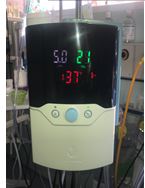
CPAP (Continuous positive airway pressure) is high flow pressured oxygen which helps keep the lungs open to support babies breathing.

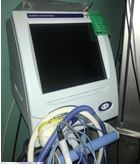
On the screen you will see numbers which will show the % of oxygen your baby is needed as well the pressures they need to support their breathing.
Ventilator- this may be seen if your baby is born unwell or early and needs assistance with breathing. The ventilator is connected to a breathing tube which will be situated in your babies breathing pipe.
You may see one or both of these pumps which will deliver fluids or nutrition to your baby to keep them well hydrated and give them the electrolytes that they need if they are unable to feed.
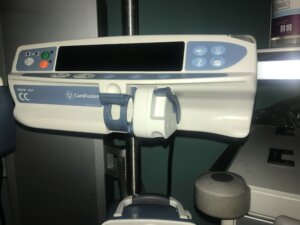
Ward round generally starts approximately at 930 am following the medical staffs’ handover. This is slightly later on a Friday due to the medical team having teaching first thing- so may be more like 10am start for ward rounds.
The ward round may consist of a consultant or a registrar depending on the needs and dependency of your baby.
If you miss the morning ward rounds you can request a medical update from the nurse caring for your baby who will arrange this if the nursing update is not sufficient.
The Neonatal staff will encourage you get enough rest and nutrition throughout the day and they will liaise with you on a daily basis to gauge how long you are able to stay with your baby and what time you can visit to engage you with feed times and nappy changes etc.
Taking the time to get a good amount of rest when you are at home is key to recovering from delivery. Time your expressing times well (if you are expressing) so that overnight you have a good block of time to sleep. Ensure that you eat and drink well. The unit has facilities to store food and drink making facilities within the parent’s kitchen room.
If you are expressing, seek advice from your midwives on good breast care and the Neonatal staff can aid with advising on expressing and maintaining milk supply. The midwives will maintain their check s until you are discharged from their care.
The Hospital has a restaurant to get hot meals on the first floor of the Prittlewell wing. It also has 2 Costas on the ground floor- the first is within the main outpatient area in the tower block and the second by the entrance of the Cardigan wing (this is your nearest)
On the unit we have 2 water coolers for you to fill up water bottles or there are plastic cups provided.
Within the parents kitchen we also have a fridge, microwave, toaster and kettle so parents/carers can bring in food to store in the fridge and use the kitchen for their food breaks.
The kitchen has milk, tea, coffee and sugar provided for parents. Hot drinks and food are not able to be consumed on the ward (use the parent’s kitchen), only cold drinks can be consumed within the ward area.
Southend’s main discharge criteria is that baby must be 1.7kg or above, 35 weeks gestation or above, and maintaining their own temperature and blood sugar.
They must be tolerating feeds, either by bottle, breast of feeding tube and gaining weight appropriately.
The medical team must have deemed baby medically fit for discharge. Every baby is different and each baby may have slightly different criteria to ensure that they are ready for home.
Baby must be off all breathing support and self-ventilating. Your baby may need to go home on some low flow cannula oxygen. This will be fixed at a certain flow; they would have been weaned of the monitoring to ensure they tolerate the fixed flow of oxygen. There will be team called BOC who provide you with oxygen support at home ready for discharge they will deliver cylinders and compressors along with some travel cylinders (this would all have been explained prior to delivery)
The Neonatal unit at Southend has 3 main areas in which babies can be cared for they are;
Intensive care (ITU) this room is used if your baby requires breathing support on a ventilator. There are 4 cots in the ITU room which each have a ventilator beside them. The ITU area has equipment that can invasively monitor blood pressure giving the nurses a constant blood pressure reading for babies.
The ITU room can also be used as an over flow for High dependency babies (HDU) where they can receive non-invasive ventilation (Continuous positive airway pressure CPAP or Vapotherm VT). In HDU they can also receive intravenous nutrition and closer monitoring.
The Special care room (SCBU) is for babies who no longer require breathing or blood pressure support. They can still have monitoring within the SCBU room but the main goal within the room is to get baby ready for discharge home.
The Neonatal unit also has side rooms which can be used if extra space is needed for ITU/HDU or SBU babies.
The unit has 2 parent bedrooms which are used for parents to be with their baby before discharge home. The parent’s rooms are just off the main ward area but staff will be monitoring baby still and are there for support and questions if needed before you are discharged home as a family.
Babies may progress through the rooms as they get better but may also need to be moved back into a higher dependent room for treatment if they need to.
Parent leaflets can be found on the Internet webpage or if you ask a member of staff the leaflets are saved to a unit iPad if you wish to read them whilst on the unit.
https://www.mse.nhs.uk/premature-and-sick-babies-neonatal
A parent Information leaflet on our system VCREATE will be given to you to sign up to our secure photo and picture sharing system. Staff will send you photos and videos of your baby when you are not able to visit.
Every new born baby has a physical examination called the NIPE (new born and infant physical exam). Baby is examined top to toe, looking into the eyes and noting all features, any family history will be noted from both Maternal (mum’s) and paternal (dad’s) families.
If your baby comes to the unit it will have a few blood tests which they will take from a cannula (small drip in a vein). The tests that are taken are a blood culture (to check for infection), a full blood count (to check blood level), CRP (to check for infection markers), blood gas (to check for oxygen and carbon dioxide levels which show us how well aby is breathing), blood glucose (which tells us the sugar in babies blood- how well baby is feeding- babies need glucose for energy), split bilirubin (SBR- jaundice level), electrolytes ( U+Es- these tell us how hydrated baby is and how well their kidneys are working). The cannula will then be secured to use for either Intravenous fluids or Intravenous antibiotics.
Blood tests can also be taken from baby’s heel. The staff will use a small heel prick to take drops of blood for sampling.
Baby may also have an x-ray so the doctors can look at their lungs or abdomen or whatever the area of concern is. They will stay on the ward for the x-ray and the portable machine will be bought to the unit for the x-ray.
Your baby on the unit may also have a hearing screen. The screen is a routine screen that is done for every baby but a more in detail screen will be done for any baby that requires a stay on the Neonatal unit.
This will depend on why your baby has been admitted to the Neonatal unit as there are many different medications your baby may receive. The most common of these are;
Benzylpenicillin and Gentamicin are antibiotics which will be commenced for your baby where there are risk factors identified or any question of infection/potential infection. They are given for a minimum of 36 hours to ensure that the blood culture taken before commencement has had the time within the lab to grow any bacteria that may require specific antibiotics or the results may come back as negative. If the results are negative then the antibiotics are stopped, if they require a specific antibiotics to treat then the antibiotics will be changed, the other antibiotics that may be used are; Flucloxacillin, Vancomycin, Acyclovir, or Cefotaxime.
If your baby requires ventilation then they may medications such as Fentanyl or Morphine to ensure that they are settled and that they tolerate the breathing tube. They may need medications to relax them to enable to doctors to get the breathing tube in place such as Suxemethonium and Atropine (to stop heart rate dropping).
To help babies breathing they may also be given something called Surfactant/Curosurf which is a medication that is given directly into the lungs to lubricate the lungs making breathing easier. This is either given down the breathing tube or a small thin catheter which is guided down the babies breathing pipe to administer the medication without placing a breathing tube, this is called Less Invasive Surfactant administration. This can only be used if the baby is breathing well by themselves and not requiring ventilation support to help them breathe.
If you baby has a very low blood pressure then a medication called an inotrope may be started to increase the blood pressure; example of this commonly used in Neonates are; Dopamine, Dobutamine, or Adrenaline. If your baby has a known ductal heart problem then a medication called Prostin will be given to keep the heart duct open so that the cardiac doctors can assess the baby’s heart condition at the specialist heart unit at a tertiary hospital (Level 3 unit).
If your baby was born pre term they may be started on some supplements to maintain their vitamin and electrolyte (salts) levels. They may be on Abidec (multi vitamin), folic acid, Sodium ferrodate (sytron- iron supplement), sodium chloride (sodium replacement), and sodium phosphate (phosphate supplement)
If a baby is very pre term they may require further supplements such as Calcium, Zinc, Vitamin d or K to maintain levels.
Diuretics such as Spironolactone, chlorothiazide and furosemide may be started for your baby if they are concerned that they are retaining fluids which may impact on their breathing.
If your baby is having difficulty feeding then Omeprazole, Gaviscon or Erythromycin may be commenced to aid with reflux or digestion of milk.
Necrotising enterocolitis (NEC) is a serious condition that can affect newborn babies, where tissue in the bowel (small and large intestines) becomes inflamed. Doctors may also describe NEC as an inflammation of the gut. NEC can affect just a small part of the bowel, or sometimes the whole bowel can be affected.
In premature infants, the cause may be related to the immaturity of the child’s digestive system. NEC involves infection and inflammation in the child’s gut, which may stem from the growth of dangerous bacteria or the growth of bacteria in parts of the intestine where they do not usually live.
If your baby is diagnosed with NEC then there are two ways in which to treat this medically with antibiotics and bowel rest (not feeding) and surgically where a transfer to a surgical hospital for review and potential surgery is needed.
At Southend we would manage any NEC baby that just requires medical management with close observations or abdomen (tummy) circumference, tube aspirates (aspirates from the stomach) and antibiotics that cover bowel infections.
Chronic lung disease is a general term for long-term breathing problems in premature babies. This condition happens when a breathing machine or oxygen injures your premature baby’s lungs. Symptoms include having trouble breathing and needing oxygen after a premature baby reaches an adjusted age of 36 weeks’ gestation. Neonatal chronic lung disease, also known as bronchopulmonary dysplasia (BPD), is the most common complication of premature birth, affecting up to 30% of very low birth weight infants.
Bronchopulmonary dysplasia (BPD) in infants refers to long-term breathing and lung problems in premature babies. Bronchopulmonary dysplasia is a serious complication of prematurity resulting from poor lung growth and lung injury. In BPD the lungs and the airways (bronchi) are damaged, causing tissue destruction (dysplasia) in the tiny air sacs of the lung (alveoli).
Many infants fully recover from this disorder. Others may have breathing difficulties during the first two years of life and even into the teen and adult years. Babies with this disorder are often in the hospital and need a lot of care and are often discharged home with oxygen. Babies who are discharged home with oxygen to support their chronic lung disease are often weaned off the oxygen by 6-12 months of age.
Retinopathy of prematurity (ROP) is an eye disease that can happen in premature babies. It causes abnormal blood vessels to grow in the retina, and can lead to blindness.
Babies born at a very early gestation can develop Retinopathy of Prematurity where blood vessels grow abnormally and uncontrollably causing damage to the light sensitive layer of the retina.
In the worst case scenario this can lead to bleeding and scarring that can pull the retina away from the wall of the eye (retinal detachment) putting the baby at risk of becoming blind.
Risk factors of Retinopathy of Prematurity include:
Patent ductus arteriosus (PDA) is an extra blood vessel found in babies before birth and just after birth. In most babies who have an otherwise normal heart, the PDA will shrink and close on its own in the first few days of life. If it stays open longer, it may cause extra blood to flow to the lungs.
Patent ductus arteriosus (PDA) is a persistent opening between the two major blood vessels leading from the heart. The opening (ductus arteriosus) is a normal part of a baby’s circulatory system in the womb that usually closes shortly after birth. If it remains open, it’s called a patent ductus arteriosus. A small patent ductus arteriosus often doesn’t cause problems and might never need treatment. However, a large patent ductus arteriosus left untreated can allow poorly oxygenated blood to flow in the wrong direction, weakening the heart muscle and causing heart failure and other complications. Treatment options for a patent ductus arteriosus include monitoring, medications, and closure by cardiac catheterization or surgery.
The Neonatal unit can be a scary environment at times with lots of alarms that may sound alarming.
The Trust test the fire alarms every week (currently on a Thursday)
Each baby in the neonatal unit generally will be connected to a monitor be that full monitoring or an apnoea monitor.
These will alarm for various reasons. The full monitoring has very tight alarm limits so that the nurse caring for the baby can monitor closely if the baby monitors out of the parameters. An amber alarm will indicate that baby has slightly fallen out of the parameters and that alerts the nurse- this could be a valid monitoring or baby could have moved around and pulled some monitoring off slightly- this is why we always look at the baby first.
The monitors also have a red alarm- again we look at baby first as the monitor is only good if it is attached fully- stickers very easily loose stickiness or are pulled off by baby. The red alarm if monitoring is correct can mean that baby has dropped markedly out of the parameters and need urgent assistance.
Yes. The Trust has access to pastoral support available for every faith.
The Chaplaincy is a multi-faith team that provides emotional, pastoral, cultural, ethical, spiritual and religious support, irrespective of religious belief.
If you would like access to any support please let the nursing team know and they can contact support via switchboard.
We do not currently have access to psychological support but we are in the process of gaining peer support for the unit as support for parents.
The Chapel is open for private prayer and meditation and services are regularly held there. In addition to the chapel there is also a prayer room for those of different faiths, together with washing facilities.
Chaplaincy is located on the 2nd floor. Just turn right out of the Neonatal unit along the corridor and 1st door to your right and is open 24 hours a day, every day of the year.
There is many different staff that you will see on the unit in various uniforms.
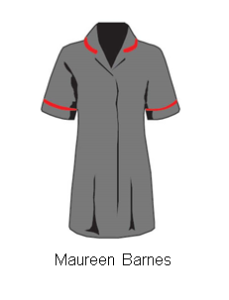
Matron Senior Sister/Sister/Charge nurse
Practice Educator Senior/Staff Nurse
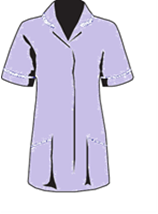
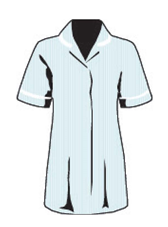
Housekeeper Nursery Nurse Domestic
There will also be hearing screeners (white uniform) and dieticians (green uniform) whom you may see within your baby’s journey.
You may also see some HCA’s on the unit who support the unit at times and they wear a darker green uniform.
The medical team will often be in plain clothes or scrubs. Within the medical team you will have a consultant, registrar and junior doctors.
Every member of staff on the unit will have an ID badge and be asked to identify themselves if not known by the staff.
Yes of course- there is no such thing as to many photos!
We also offer a system called vCreate- we gain your written consent and we are then able to send videos and phots of your baby securely to your email or phone number (whatever details your register with). We can send photos or videos to you if you are unable to visit due to sickness for example.
We ask that you do not film or take photos of any other babies or staff without consent.